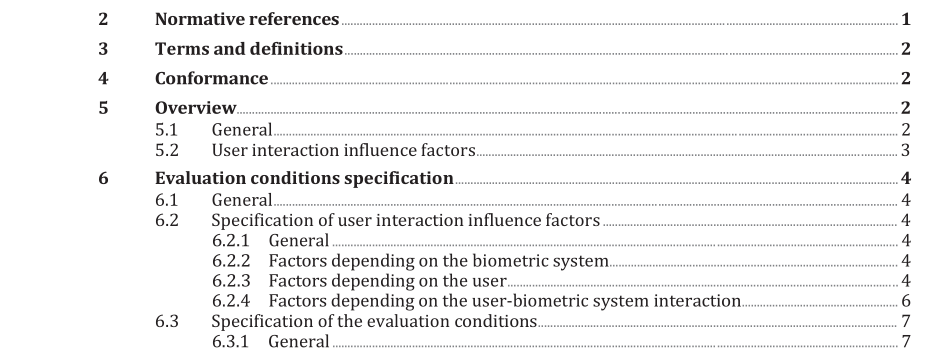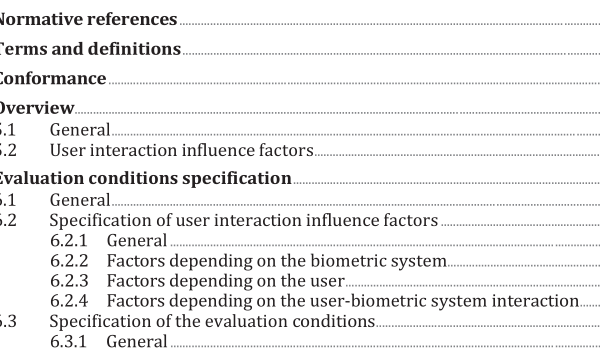ISO IEC 21472:2021 pdf download – Information technology — Scenario evaluation methodology for user interaction influence in biometric system performance.
3 Terms and definitions For the purposes of this document, the terms and definitions given in ISO/IEC 19795-1, ISO/IEC 2382- 37 and the following apply. ISO and IEC maintain terminology databases for use in standardization at the following addresses: — ISO Online browsing platform: available at https://www.iso .org/obp — IEC Electropedia: available at https://www.electropedia .org/ 3.1 reference evaluation condition REC test condition reflecting established device factors, user factors or user interaction factors Note 1 to entry: Results generated under these test conditions are compared against results generated under corresponding target evaluation conditions ( 3.2 ). 3.2 target evaluation condition TEC test condition reflecting new or alternative device factors, user factors or user interaction factors Note 1 to entry: Results generated under these test conditions are compared against results generated under corresponding reference evaluation conditions (3.1). 3.3 user interaction influence in performance measurement of how the performance of a biometric system can differ from a reference evaluation, based on subjects using the system in operational or scenario conditions 3.4 usability testing testing relating to the extent to which a product can be used by specified users to achieve specified goals with effectiveness, efficiency and satisfaction in a specified context of use Note 1 to entry: See ISO/IEC 9241-11. 4 Conformance To conform to this document, a user interaction influence performance evaluation shall implement the requirements contained herein, including one reference evaluation condition (REC) and at least one target evaluation condition (TEC). 5 Overview 5.1 General Testing the influence of user interaction in the performance of a biometric system entails execution of one scenario evaluation under reference evaluation conditions (REC) and at least one evaluation under target evaluation conditions (TEC). These evaluations are identical except for changes to the user interaction influence factors being studied. For each set of condition(s), test subjects interact with the biometric system as many times as required. The number of times the interaction is repeated shall be defined at the time of the evaluation design, considering parameters such as: available time for the evaluation, availability of test crew, effort to be applied for each test crew subject, cost, etc. Biometric system recognition outcomes and (optionally) test subject interactions are recorded. From such results, it is possible to calculate biometric system performance (e.g. error rates and throughput rates) for the specific evaluation condition(s). By comparing performance results generated under REC and TEC, the influence associated with user interaction factor(s) can be quantified. A schema of the evaluation methodology model is shown in Figure 1. In scenario evaluations, biometric systems are assessed in modelled environments considering a real-world target application and population. Requirements for scenario testing and reporting are defined in ISO/IEC 19795-2.
ISO IEC 21472:2021 pdf download – Information technology — Scenario evaluation methodology for user interaction influence in biometric system performance






